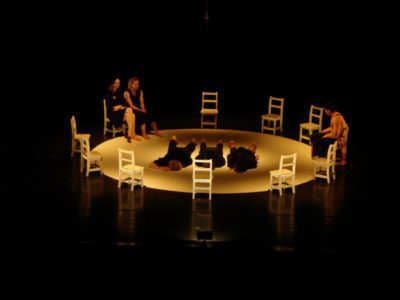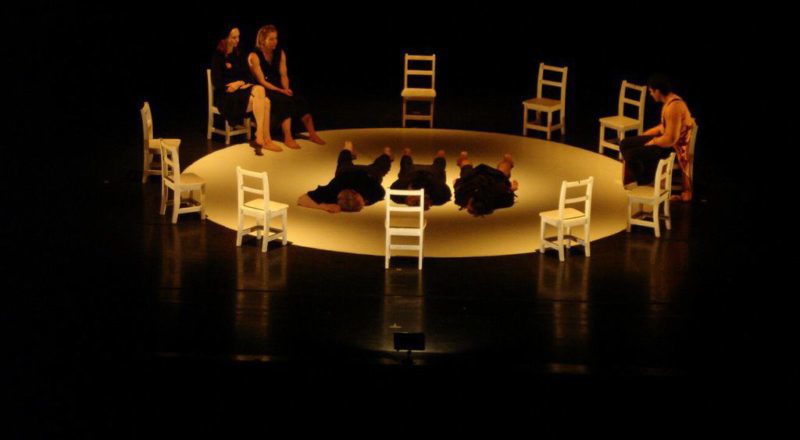INTERVIEW: Pilobolus dances back to NYC with unique expressive movement

Pilobolus, the modern-dance company that relies on collaboration and creativity to impress audiences, returns to New York City for an engagement at New York University’s Skirball Center for the Performing Arts. The dancers, performing two separate programs over the course of several evenings, will be in Greenwich Village Nov. 17 to Dec. 4.
Robbie Barnett, a native of the Adirondack Mountains in New York, helped found Pilobolus in 1971 with a group of fellow graduates from Dartmouth College in Hanover, New Hampshire. What started as an idea among an energetic group that had no dance training or desire to follow the rules has blossomed into one of the most respected companies in the world. Annually Pilobolus plays before more than 300,000 people, and they’ve been featured on shows as varied as the Academy Awards and Late Night With Conan O’Brien.
At the heart of Pilobolus’ work in 2016 is still that initial idea from 45 years ago: creative, boundary-breaking fun.
At the Skirball engagement, the company will offer two programs that include such works as All Is Not Lost, a collaboration with the band OK Go; the New York premiere of Thresh|Hold by choreographer Javier De Frutos, [esc], a piece that features the magical influence of Penn & Teller; Rushes from Pilobolus charter artistic director Robbie Barnett, plus Inbal Pinto and Avshalom Pollak; and the classic Day Two from 1981.
“We have a couple of new pieces, which we always do when we come back to New York,” Barnett said recently in a phone interview. “I think a pretty well-rounded selections of work that we’ve done in the last few years, plus a couple of older works that we haven’t done in a few years.”
The Pilobolus team tries not to repeat the same programs when they return to a city, and Barnett said there are many considerations to keep in mind when selecting the works of art. “You’re looking for maximum contrast of dark and light, fast and slow, music variation, scale of the works, narrative vs. non-narrative pieces,” he said. “We’re trying to do things that are maximally various.”
Rushes, which is included in program A, promises to be a highlight. The piece is the product of true collaboration and helped Pilobolus venture down new pathways with their presentations. The work dates back to 2007, an “interesting point” for the dance company, Barnett said.
The charter artistic director was sitting with his partners at a cafe in the morning hours when Hurricane Katrina was flooding New Orleans. The news felt apocalyptic to Barnett, and the conversation soon turned toward the dance company’s history and the number of years that had passed since 1971. They wondered, in this reflective, contemplative state, what the future would hold.
“We were looking at what our original hopes were when we began for ourselves, for our company,” Barnett said. “The overwhelming impression we had was that it was our collaboration that really defined our company. People do good work. They do bad work. People do big things and smaller things. There’s lot of ways you can vary your efforts. … We’ve tried different configurations of people, but we have always worked among ourselves inside the company. It’s very, very rare that we’ve ever reached outside the range of our family here, and we thought it would be interesting going forward to see what would happen if we invited some other people to come into our madhouse sort of and see what we could do together, not so much hiring people to choreograph on Pilobolus, but to really to bring them in and to see what we could do together.”
They had seen a show by the company of Pinto and Pollak, two prolific and celebrated dancers, and Barnett was hooked. “We liked them,” he said. “So we asked them to spend a couple of weeks with us, which they did, and they arrived from Israel on a very, very snowy February. It was quite a shock. They had a young son with them, and I think Avshalom’s mom was with them. It was quite a crew, and they came in at about a foot-and-a-half of new snow. But we spent a few weeks together working, and it was a great pleasure for us all. We decided we would go on and do something together, and Rushes was the upshot of that. Since then, we’ve gone on, and we’ve worked with quite an array of other people from a variety of professions. And it’s that first event with Rushes that has really defined in many ways our creative project for the last 10 years.”
When Pilobolus brings back a classic routine, they need to dust it off a bit, and Barnett said it can be an interesting process to see a new cast take a work in a different direction.
“We tend to be quite liberal with new cast members, kind of interested to see what they’ll do with the piece,” he said. “One of the things about modern dance is it’s essentially an oral tradition. There are videotapes of dances, but very few of them have ever had any kind of written notation. And so you’re really kind of relying upon people to tell somebody what to do, and if the choreographer is alive, of course, the choreographer can be specific about it. But when it’s handed from a dancer to a dancer, the dancer will tend to tell you what they did. There’s a lot of room for flexibility in there. Pieces have an interesting way of changing through the years. It’s a little bit like a telephone conversation. You can mishear a few things, and interestingly a piece will go off in another direction. We’re pretty open to see the way things go.”
The choreographic structure is definitely passed from performer to performer, but the layers of personality, character and interpretation make each incarnation unique from the last. Barnett called this “spontaneous action” of “smart people” an exciting process that can change a piece.
“Once a piece has been performed for a few years, you generally get a pretty good cross-section of audience response,” Barnett said. “With a piece like Day Two, we can be fairly confident within reason what people are going to see in there. It’s been done in an awful lot of places for an awfully long time. We found that some countries react differently. Certain cultures overall react differently, but I haven’t found so much that the generational difference matters so much.”
Nowadays Barnett finds himself in the role of supporter for the dance company he helped to launch. He called himself a “benevolent observer” who is no longer involved in the day-to-day process. Those duties have been handed off to executive producer Itamar Kubovy and associate artistic directors Matt Kent and Renée Jaworski. “They ask me occasionally what I think about things, but it’s definitely their company to push forward now,” said Barnett, who shares the title charter artistic director with Michael Tracy
This many years after Pilobolus’ founding, it still amazes Barnett that the company is at the center of modern dance and continues to impress audiences. More than four decades of history are now on stage.
“We never were really doing this with much thought beyond tomorrow,” Barnett said. “The company was always sort of a lifestyle choice. We were never very clear on where it was going to go. Its ability to sustain itself through the years … I think, at first, it was surprising. I’ve come to accept it more and believe that it does spring from something that worked. As I said before, I think it really has to do with collaboration. It’s a very rich, if inefficient, way of doing things. I think there’s … a vibe that we’ve tried to sustain over the years. That’s people enjoying doing what they’re doing together. We worked very hard to make Pilobolus a nice place to live as well as a place to work. We’re up here in the country. People come out of the city. A lot of times they’ll really not quite sure what they’re going to do. They discover in the afternoon they end up going running in the woods as opposed to going to a bar, which to some degree has added to our longevity, too.”
By John Soltes / Publisher / John@HollywoodSoapbox.com
Pilobolus is currently playing a series of performances at NYU’s Skirball Performing Arts Center. The engagement runs through Dec. 4. Click here for more information.

